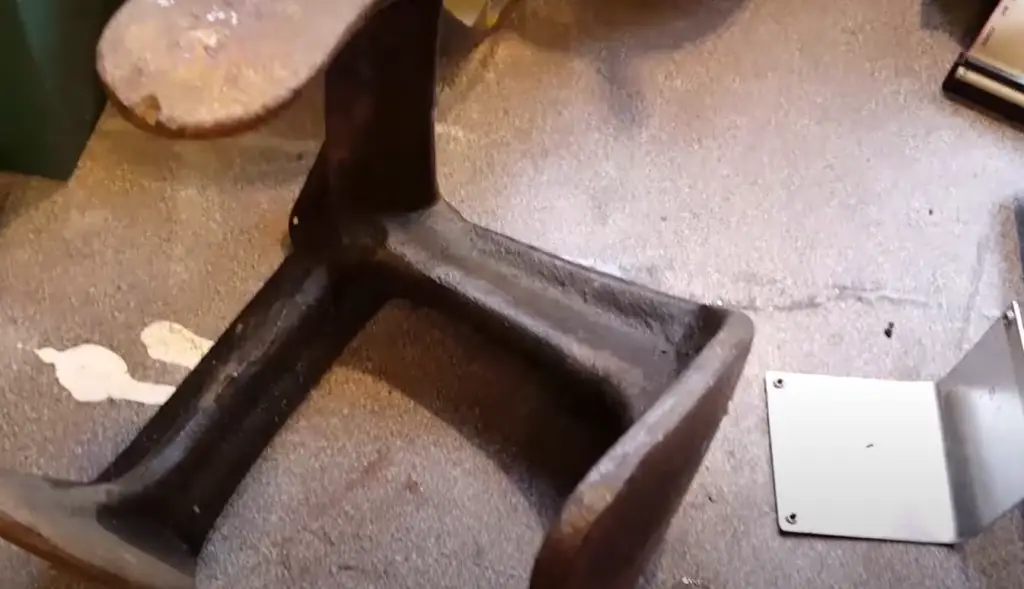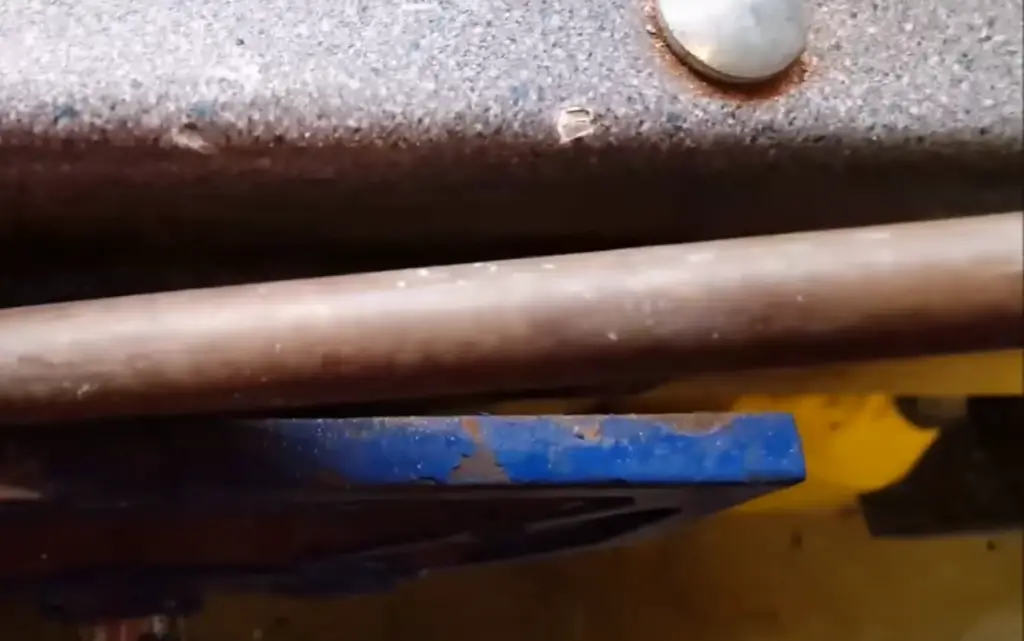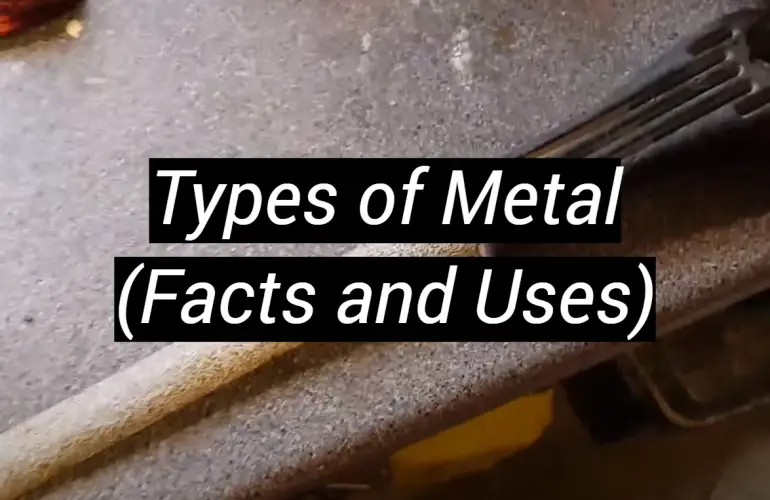Are you curious about different types of metal and what they are used for? If the answer is yes, then keep reading! Although there are thousands of known elements in chemistry, only a small number can be classed as metals.
Metals have lots of special properties that make them important to our lives – for example, they can be used to make strong buildings or to help us prepare and store food.
In this blog post, we’ll explore various types of metals, their uses and interesting facts about them. So read on if you want to learn more about the fascinating world of metals!
Types of Metal
Steel
Steel is a metal that we use a lot in our everyday lives. It is made from iron and other elements like carbon, manganese and silicon. Steel is strong, durable and affordable, which makes it a good choice for construction projects or manufacturing applications.

Steel can also be used to make bridges or ships, as well as cutlery and kitchen utensils.
Carbon Steel
Carbon steel is a type of steel that has more carbon in it than regular steel. It is hard, strong and durable – making it better for use in things like bridges or buildings.
Carbon steel also works well with heat, so it is often used to make pots and pans or things that transfer heat like heat exchangers. [1]
Alloy Steel
Alloy steel is a type of steel that has been mixed with other elements like nickel, molybdenum and chromium. This makes the metal more durable than regular steel and able to withstand higher temperatures.
Stainless Steel
The most popular type of metal we use nowadays is stainless steel. It has a high chromium content, which makes it resistant to rust and shiny.
Stainless steel is used to make kitchen equipment, medical tools and vehicle parts. It is also very popular in the construction industry because it does not break easily.
Iron (Wrought or Cast)
Iron is a common element that has been used for a long time to make different objects. Iron can be either wrought or cast. Wrought iron is hammered into shape from an ingot.
Cast iron is melted down and poured into a mould. Wrought iron can be bent more easily than cast iron so it is often used to make furniture or fences. Cast iron is more likely to break but it can be used for heavier things like stoves or engine blocks.
Aluminium
Aluminium is an abundant metal that has many uses in industry and everyday life. It is light, strong and non-corrosive, making it a great choice for airplanes, bicycles or boats. Aluminium can also be recycled, so it is often used in packaging or to make cans for food and drinks.
Magnesium
Magnesium is a metal that can be used for many things. It is light and strong, so it is often used to make car parts or aircraft components.

Magnesium also has anti-inflammatory properties, making it useful for medical treatments like relieving muscle cramps or reducing the risk of heart disease.
Copper
Copper is a soft metal that can be used to make coins and jewellery. Copper is also good at conducting heat and electricity, which makes it ideal for making wiring or electrical components like circuit boards.
Brass
Brass is a type of metal alloy that is made from copper and zinc. It has a golden colour and is used for things like trumpets, door knobs or furniture. Brass is often found in coins, jewellery and statues because of its attractive appearance.
Bronze
Bronze is an alloy of copper and tin. It is strong, durable and resistant to corrosion – making it perfect for things that need to be kept outside like statues or fountains. Bronze is also often used in musical instruments because of its ability to produce a clear sound.
Zinc
Zinc is a metal that can be used for galvanising steel or making jewellery, coins and even musical instruments. Zinc is also an important part of the human body – it helps keep our cells healthy and fight off infection. [1]
Titanium
Titanium is a strong, light and corrosion-resistant metal. It is often used in aerospace applications like missiles or aircraft. Titanium is also becoming more popular for use in jewellery and other items due to its strength and attractive appearance.
Tungsten
Tungsten is a metal that is very hard. This means it does not scratch or dent easily. Tungsten is often used to make tools like drill bits or saw blades.
Tungsten has a high melting point, which means it does not corrode easily. Tungsten also emits a bright light, which makes it good for lightbulbs.
Adamantium
Adamantium is a fictional metal made popular by Marvel comics. It is indestructible and almost impossible to break or cut.
Nickel
Nickel is a metal that is strong and does not rust easily. People use nickel to make coins, jewellery and parts for electric devices. Nickel can also be used to find things like underground wires and pipes because it is attracted to magnets.
Cobalt
Cobalt is a strong, corrosion-resistant metal that has been used for centuries.

It is often mixed with other metals to make them stronger and more durable. Cobalt can also be used to make magnets and batteries because it reacts easily with electricity.
Platinum
Platinum is an expensive metal that is very rare. It is known for its strength and resistance to corrosion. Platinum is often used for jewellery and watches, but it can also be found in industrial applications like catalytic converters or fuel cells.
Tin
Tin is a soft metal. Tin is used to make cans and containers. Tin makes other metals stronger and does not corrode as much. Tin can also be used in electronic components like transistor radios or microphones.
Lead
Lead is a heavy metal with many uses. It has been used for centuries to make things like pipes and ammunition. Lead is also used in batteries, fuel cells and TV screens.
Although it has many useful properties, lead can be toxic if ingested or inhaled. Therefore, people should take precautions when handling lead products.
Silicon
Silicon is a material that is used to make electronic products such as computers, cell phones, and solar panels. It is also found in many cosmetics and skincare products because it can help keep skin hydrated. When mixed with other metals, it forms alloys which are stronger than pure metals.
Metal types have many uses in industry and everyday life. They are all unique and have their own characteristics that make them valuable. When used correctly, metals can be incredibly useful and help create products that are essential for modern life.
Understanding the facts and uses behind each type of metal will help you make informed decisions when buying or using it. Knowing these types of metal facts and uses can also provide insights into new innovations in engineering, construction, electronics, and more.
FAQ
What are the types and uses of metals?
The types and uses of metals vary greatly, depending on the type of metal. Some examples include aluminum, which is used to make aircraft parts; copper, which can be used for electrical wiring; zinc, which can be used for galvanizing steel or making jewelry, coins and even musical instruments; titanium, which is often used in aerospace and medical applications; tungsten, which is strong and durable and often used in tools or lightbulbs; nickel, which can be found in coins and electrical components; cobalt, which has been used for centuries to make magnets and batteries; platinum, which is rare but strong and resistant to corrosion; tin, which is used to make cans and containers; and lead, which is heavy and toxic but has many uses in pipes and ammunition.
What are the strongest metals?
The strongest metals are tungsten, titanium, and adamantium. Tungsten is a strong metal that does not corrode easily. Titanium is light yet incredibly strong; it has a high tensile strength and is often used in aircraft and medical applications.

Adamantium is a fictional metal from Marvel Comics; it has been said to be indestructible, but unfortunately does not actually exist in real life.
What are some of the most common metals?
Some of the most commonly used metals are aluminum, copper, steel, iron, lead, and zinc. Aluminium is lightweight but strong; it is often used for aircraft parts, cans, and building materials.
Copper has excellent electrical conductivity and can thus be found in wires; steel is a combination of iron and carbon that is used to make many household items; iron is the main component of steel; lead is heavy and toxic but has many uses in ammunition and pipes; and zinc is a corrosion-resistant metal that is used for galvanizing steel, making coins, jewelry, and musical instruments.
What are 3 interesting facts about metal?
- Metal was used to make tools and weapons by early humans as far back as 6000 BC.
- The Statue of Liberty in New York City is made out of 304 stainless steel.
- Copper has been used for plumbing since ancient times; the Romans built their famous aqueducts with copper pipes.
What are the 5 basic metals?
The five basic metals are iron, aluminum, copper, lead and zinc. Iron is the main component of steel; it is strong and heavy. Aluminium is lightweight but strong; it is often used for aircraft parts, cans, and building materials. Copper has excellent electrical conductivity and can thus be found in wires.
Lead is heavy and toxic but has many uses in ammunition and pipes. Zinc is a corrosion-resistant metal that is used for galvanizing steel, making coins, jewelry, and musical instruments.
There are five metals that everything else is made from. They can be combined with other elements to form alloys. Alloys are stronger or more resistant to corrosion than pure metals. Metal is important in our everyday lives, so it is good to know some facts and uses about each type of metal.
What are the 3 types of metals?
There are three main types of metal: ferrous, non-ferrous, and alloy. Ferrous metals have iron in them and are attracted to magnets. Examples of ferrous metals are steel, stainless steel, and cast iron. Non-ferrous metals do not have iron in them and are not attracted to magnets.
Examples of non-ferrous metals are aluminum, copper, brass, bronze, and lead. Alloys are made by combining two or more different types of metal. They can be either ferrous or non-ferrous.
An example of a ferrous alloy is bronze (made from copper and tin). An example of a non-ferrous alloy is stainless steel (made from iron, chromium, and nickel). Alloy metals can have properties that pure metals do not have.
What is the most abundant metal?
There is a lot of aluminum on earth. It is in the ground. Aluminum is a metal that does not rust and is strong. You can find it in many things such as cans, parts of airplanes, buildings, and foil wrap.
What are the 5 rarest metals?
The five rarest metals are rhodium, iridium, palladium, osmium, and platinum. Rhodium is a silvery-white metal that has high reflectivity and is used in jewelry and catalytic converters. Iridium is a grayish-white metal that is used in spark plugs and hardening tools. Palladium is a silvery-white metal with a high melting point; it is used to make jewelry and electronics components.
Osmium is blue-gray in color and has the highest density of any metal; it is used as an alloying agent in metallurgical applications. Platinum is a silvery-white metal that is highly resistant to corrosion and oxidation; it is also used in jewelry and electronics components. All five of these metals are rare and expensive because they are difficult to mine and refine.
What are the 4 common uses for metals?
The four most common uses for metals are construction, manufacturing, transportation, and jewelry. Metals are strong and durable, making them ideal for use in the construction of buildings and infrastructure. They are also used in the manufacturing of cars, electronics, consumer goods, and industrial machinery.

Metals are often used for transportation as parts for vehicles such as bicycles or trains. Jewelry is another common use for metals; they are often fashioned into rings, necklaces, and other decorations. Metals have been used since ancient times in the creation of tools and weapons; they are still integral to our lives today.
What was metal originally used for?
People have used metal since ancient times. It was first used to make weapons and tools. This helped people in battle and made it easier to farm and build shelters.
Metal was also used for jewelry and ornamentation as early as 4000 BC. By 1000 BC, brass (an alloy of copper and zinc) was being used to make coins, decorations, household items, and more.
Eventually, metal was used to construct large structures such as cathedrals and castles. This revolutionized the way we build, paving the way for modern architecture.
What is the most useful metal?
Iron is the most useful metal because it has many properties that make it ideal for a variety of uses. It is strong, durable, and malleable, making it perfect for construction. It also has excellent thermal and electrical conductivity, which makes it great for transportation applications such as cars or trains.
It can also be alloyed with other metals to create stainless steel and other useful alloys. Iron is also abundant, making it a cost-effective metal for many applications.
Which metal is used most in the world?
Steel is the most used metal in the world. It is an alloy of iron and other elements such as carbon, manganese, chromium, and nickel. It has a high tensile strength and is very durable, making it ideal for construction and transportation applications.
Steel is also non-corrosive and resistant to rusting, making it perfect for use in applications such as ships, bridges, and buildings. It is also lightweight and cost-effective, making it the metal of choice for many industries.
How are metals recycled?
Metals can be recycled and used again. The most common way to recycle metals is by melting them down and making them into new shapes. This can be done with all kinds of metals, including aluminium, copper, iron, brass, gold, silver, and more.
Metals are also recycled through a process known as remelting, where scrap metal is melted down and then cast into new shapes. Metals can also be recycled through mechanical processes such as shredding or crushing. Recycling metals helps to conserve resources and save energy.
What are the benefits of using metals?
Metals are a good choice for many reasons. They are strong and will not break easily. They conduct electricity and heat well. This makes them good for cars and trains.
You can also mix metals together to make new kinds of metal like stainless steel. And, when you are done with them, you can recycle metals so they can be used again.
How do metals interact with water?
Many metals can interact with water and other liquids. Some metals, such as iron and aluminum, will also react with oxygen in the air. This forms a layer that prevents further reactions with water. But other metals, such as copper and lead, are much more reactive.
This means they will dissolve quickly when they come into contact with water. Most metals can be corroded by water, so it’s important to take measures to stop this from happening. You can do this by using protective coatings or painting on the metal surfaces.
Why are metals important for our daily lives?
Metals are an essential part of our daily lives. They are used in countless applications, from construction to transportation.
Metals have excellent properties that make them great for these uses, such as their strength and durability. Metals also conduct electricity and heat well, making them perfect for electrical and mechanical applications.
Why are metals important for industrial applications?
Metals are important for many industrial applications. They are strong and durable, and have good properties such as thermal and electrical conductivity. Metals can also be mixed with other metals to create new kinds of metal that have different properties.

This makes them great for many industrial applications such as construction, transportation, and even electronics. Metals are also easy to recycle, making them an environmentally friendly choice.
Does recycling metals help the environment?
Yes, recycling metals can help the environment. Recycling metals helps conserve resources, reduce pollution, and save energy. It also reduces our reliance on mining minerals from the ground, which can cause a lot of damage to the environment.
Do metals have a low carbon footprint?
The production of metals can cause pollution because of the energy used in mining and smelting them. However, recycling metals helps to reduce this pollution because we do not need to mine new materials.
Additionally, some metals such as aluminium are very light, so they require less energy to transport than many other materials. This also helps to reduce their carbon footprint.
Does metal cause pollution?
The production of metals can cause air and water pollution from the chemicals released during the smelting process. But, most metals are recyclable, so recycling them helps to reduce the amount of new metal that needs to be produced and reduces pollution. Metal also does not emit harmful gases into the atmosphere like some other materials do.
What safety measures should be taken when handling metals?
When working with metals, you should wear gloves, goggles and a face mask. Avoid breathing in any dust or fumes that are released while cutting, grinding or welding metal.
Make sure that all tools and machinery used when working with metals are in good working order. Finally, make sure that all materials used for metalworking are stored properly and out of the reach of children.
Does metal rust?
Yes, some metals are prone to rusting. Iron and steel are the most commonly used metals that can corrode when exposed to water and oxygen. Rust is a type of corrosion that forms an orange-brown layer on the metal surface. To protect against rusting, you should take measures such as painting or using protective coatings on the metal surface.
Are there any other concerns when using metals?
Aside from rusting and corrosion, it is important to be aware of the risk of fire when working with metals. Metals can become very hot when exposed to high temperatures, so you should always take safety precautions such as wearing protective gear and having a fire extinguisher nearby.
Additionally, metals can be toxic when inhaled or ingested, so you should avoid breathing in any dust that is released while working with metal and keep it away from food or drinks.
Is it easy to recognize different types of metals?
Different types of metals can be difficult to identify because they have similar characteristics. However, it can help to know the properties of each type of metal. Usually, ferrous metals (such as iron and steel) are magnetic and heavier than other metals.
Non-ferrous metals (such as aluminum or copper), on the other hand, are not magnetic and lighter. Additionally, some metals have a distinct color. For example, brass is yellowish in color and gold has a distinct yellowish-orange hue.
Can metals be reused or repurposed?
Yes, metals can be reused or repurposed. There are many ways to reuse metal such as scrap metal art, making furniture with old pipes, creating jewelry from old coins and more.

Additionally, metals can also be melted down and reshaped into new forms for a variety of uses. This is a great way to reduce waste and conserve resources.
Does metal last a long time?
Yes, metal can last a very long time. Metals are strong and durable and are resistant to wear and tear. This makes them ideal for long-term use in a variety of applications.
Additionally, some metals such as stainless steel are corrosion-resistant and have low maintenance requirements, so they can last even longer.
Useful Video: Identifying metals only using a file and a magnet
Conclusion
There are many different types of metals, and they have lots of different uses. For example, ductile carbon steel is used for girders in skyscrapers, and malleable copper is used for electrical wiring.
Metals have been used throughout history to build all sorts of things, from small items like buttons to large-scale materials like bridges.
There are many features that make metal a good choice for many things. Metal is strong, can absorb heat without losing its shape, conducts electricity well, and is affordable. This makes metal a good choice for everything from zirconium components to stainless steel utensils.
We explored different types of metal in this blog post, their properties and how people use them in different ways.
We hope this inspired you to explore more! To learn more about metals, keep researching or ask a local expert for help. Thank you for reading!
References:
- https://makeitfrommetal.com/different-types-of-metal-facts-and-uses/






